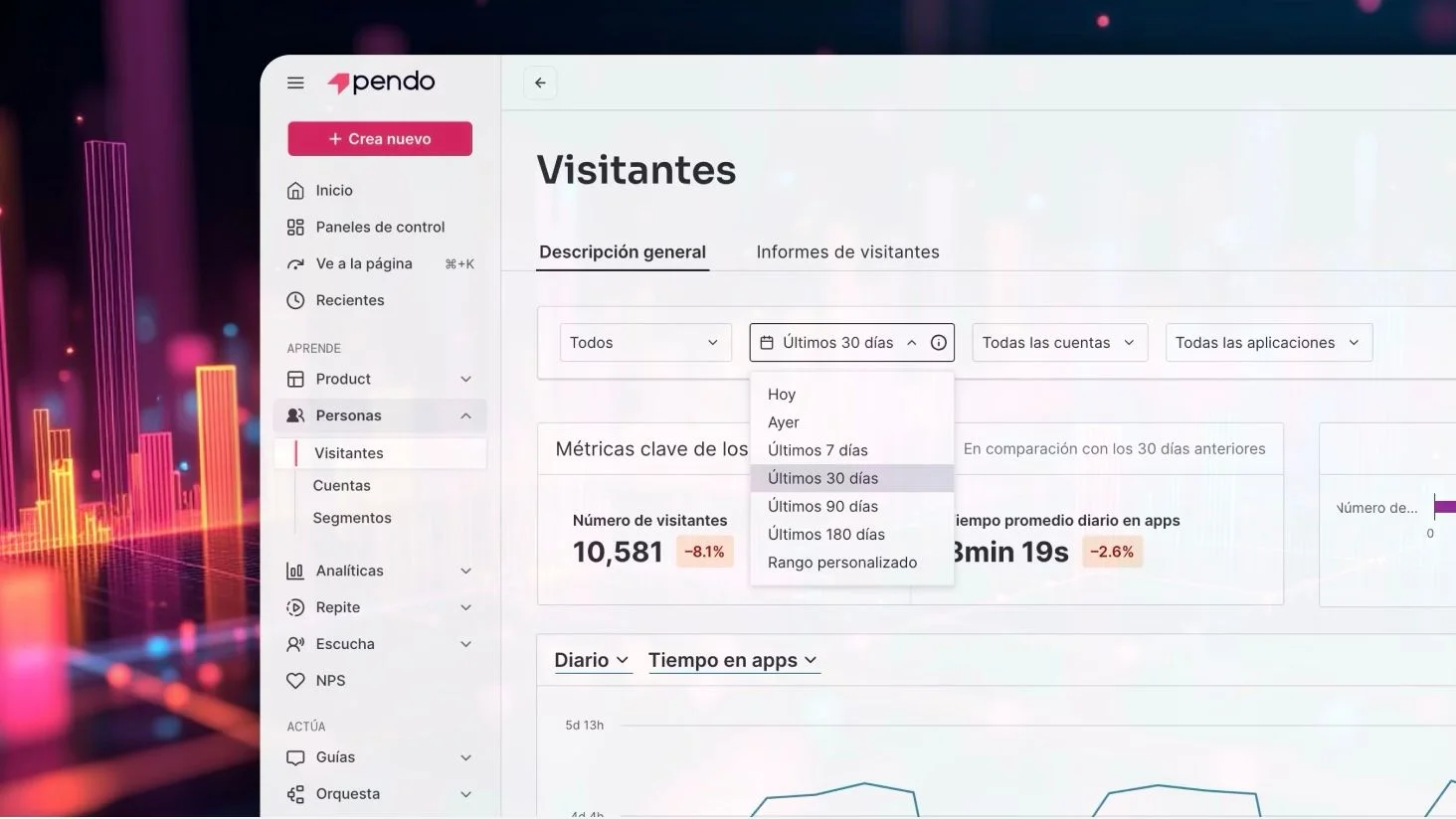ソフトウェアの構築には多くの妥協点がつきものです。その中で最も困難なのは、速度と確実性のどちらを選ぶかです。迅速に行動すると、間違えるリスクがあります。自信を持って行動すると、速度が遅くなりすぎるリスクがあります。
ほとんどの組織は、顧客の声に耳を傾けることに関しては、どちらかを実現するのにさえ苦労しています。それはなぜでしょうか?フィードバックは以下が理由で乱雑しているからです。
- 散在するユーザーインサイト:フィードバックがツール、ドキュメント、Slackメッセージにまたがって存在しています。あらゆる場所に存在すると同時に、どこにも見つかりません。
- 手動のトリアージ:整理や分類という作業は何時間もかかります。
- コンテキストの欠如:コンテキストがないと、誰かが意見を言った理由がわからず、優先順位を付け焦点を置くことが難しくなります。
- やりとりを完結させる手段がない:ユーザーへのフォローアップは手動で行われ、まとまりがありません。
上記すべてが貴重なフィードバックを雑音に変え、より遅くリスクの高い意思決定につながります。
適切に行われたユーザーフィードバックは、貴重な財産になります
2024年5月にPendoリッスンをリリースしたとき、私たちはユーザーフィードバックについてのスクリプトを逆転させ、以前は混乱を起こし断片化されていたユーザーフィードバックを、ユーザージャーニー全体で強力かつまとまりのあるストーリーに変換しました。
Pendoリッスンの最新の機能、Feedbackエージェントなら、インサイトを探る必要はありません。尋ねればよいだけです。
PendoリッスンのFeedbackエージェント:新しいデジタルProdOpsマネージャー
次のシナリオを想像してみてください。CEOがあなたとの1対1の対面で「ダッシュボードを再構築する必要がある。お客様A社がひどい出来だと言っている。全部作り直せ」と言いました。
これは典型的なシナリオです。1つの何気ないコメントが、数週間にわたる計画、関係者へのインタビュー、アンケート、営業フォローアップに発展し、そのフィードバックが幅広いユーザーベースを表しているかどうかを判断するはめになります。
ここで慌てるのではなく、Feedbackエージェントに「ダッシュボードについてどのようなフィードバックがありますか」と尋ねることができます。
Feedbackエージェントは、AIが生成し、実際の顧客の声によって裏付けられ、その情報に直接関係するテーマの完結な要約を数秒で提供します。Google AI Overviews(AIO)のようだと考えてください。通常、私たちが必要とするのは概要のみです。そうでない場合は、情報を掘り下げて検証します。
もしかすると、インサイトは「誰もがダッシュボードを嫌っている」でなく、「多くのユーザーがフィルタリングのオプションに不満を抱いている」のかもしれません。それには、お客様のA社も含まれます。
データに基づいたインサイトをCEOに提供し、ロードマップを予定通りに進めます。そうすることで、プロダクトマネージャーは最終的に、直感的でなく証拠と自信に基づいて「いいえ」と言えるようになります。
「PendoリッスンのFeedbackエージェントを使用する前は、何日もかけて手作業でフィードバックをバグ、機能リクエスト、反復テーマなどのカテゴリに分類していました。このような分類は主観的で、時間がかかり、重要なインサイトを見落としがちでした。現在では、PendoリッスンがAIを活用して初期のトリアージを行うので、プロダクトマネージャーは自然言語を使用して自身の業務に関連するトレンドを発見し、重要なインサイトに直接アクセスしています。」
– Adrian Mendoza氏、Cin7、デジタル体験アナリスト
コンテキストが最も重要
Feedbackエージェントは、アプリ内アナリティクス、ユーザーセンチメント、セッションリプレイに接続されており、定性的なデータのコンテキストを提供します。顧客の意見を確認するだけでなく、以下を理解できるようになります。
- 送信元:これは高価値のアカウントですか、無料ユーザーですか?
- ユーザーの行動:フィードバックを提供する前後にユーザーが達成しようとしていたタスクは何ですか?あなたはアプリ内体験のセッションリプレイを視聴できますか?
- ユーザーのフィードバックの提供場所:アプリ内、Gong Call、またはメール経由ですか?
プロダクトに対する実際の行動と結びついた、これほど深いカスタマーインテリジェンスを得られるのはPendoリッスンだけです。
そして何よりもすばらしいのは、Pendoリッスンならアプリ内ガイドやメールを通じてやりとりを完結できる点です。つまり、曖昧なフィードバックを追って混乱した状況に入り込む必要も、誰かが顧客からの苦情を転送するたびにロードマップを書き直す必要もなくなります。
Feedbackエージェントで自信を持って迅速に行動
Feedbackエージェントは、プロダクトチームが顧客調査で手を抜くことなくすばやく作業を進めるという、以前では不可能だと思われていたことを実現するのに役立ちます。
フィードバックはすでに一元化され、トリアージされているので、迅速に行動できます。また、SalesforceやZendeskなど、すでに使用しているツールからインサイトを引き出すことができ、手作業で情報をつなぎ合わせる必要もありません(私たちは価値をさらに高めるために、常に新しい情報源を追加しています)。
Pendoリッスンのエージェントを使用すると、聞き伝えや裏付けに乏しい証拠に依存する必要がないため自信を持てるようになります。引用元に裏打ちされ、明確かつデータで裏付けられた要約を入手し、すぐに共有することができます。
「Feedbackエージェントによりデータが即座に理解しやすくなり、チーム全員が関連情報にすぐにアクセスできます。以前は、緊急のフィードバックがシステムのあちこちに散在し、誰かが積極的に擁護したときにのみ表面化され、多くの重要な項目は見落とされていました。」
– Adrian Mendoza氏、Cin7、デジタル体験アナリスト
時間(と戦略セッション)を取り戻す
正直なところ、私たちのほとんどは物事を深く考えることにまで手が回りません。長期的なプロダクトビジョンセッションや戦略的な賭けに時間を費やしています。なぜでしょうか?その理由は、フィードバックを追いかけ、関係者向けの資料を準備し、社内で起こった最新のホットテイクによって生じた問題を解決することに忙殺されているからです。
Feedbackエージェントはその状況を変えます。フィードバックを長時間かけて調査する代わりに、その時間を投資に充てることができます。また、ロードマップについて議論するたびにリサーチプロジェクトを計画する代わりに、質問するだけで信頼できる回答を得ることができます。
その結果、よりスマートに優先順位をつけ、無駄な開発サイクルを削減し、利用率は改善され、チームの連携が強化されます。
ユーザーフィードバックは問題の1つにしかすぎません
フィードバックのポイントソリューションは、一元化と分析で終わってしまうことがよくあります。これらはユーザーの意見を示しますが、ユーザーが誰で、何をし、次にどんな行動を取るかは推測するしかありません。
Pendoは違います。次を組み合わせることができるのはPendoだけです。
- 定性的なフィードバックを介したユーザーの意見と感情
- ユーザーが誰で、プロダクトアナリティクスを通じて何をしているか
- セッションリプレイとコンテキストインサイトを介して行う理由
- アプリ内ガイドやメールなどのターゲットされたコミュニケーションを介してユーザーが取る行動
行動データの裏にある「理由」を理解する
たとえば、Feedbackエージェントを使用しているときに、定性データで「色やグラフを変えられなくてイライラする」や、「グラフの色のせいで読みにくい」といった一般的な不満の声に気づいたとします。
グラフの色を変更する機能をずっと前に追加したのに、なぜユーザーはそのことに気づかないのでしょうか?それを理解するために、いくつかのセッションリプレイを確認すると、グラフにカーソルを合わせなければこの設定にアクセスできないということをユーザーは知らないことに気づきます。
粘り強いユーザーなら最終的にこれを理解しますが、初めて使用するユーザーはそれを見逃してしまい、混乱、サポートチケット、低いNPSスコアにつながります。
これを修正するには、この機能を定期的に使用しないユーザーにターゲットを絞ったPendoセグメントを作成します。次に、必要なときにカラーオプションの場所を正確に示すガイドをリリースします。このガイドは経験豊富なユーザーには表示されないため、ワークフローはスムーズに保たれます。機能を微調整したり、より明確にしたりする場合は、簡単なアプリ内メッセージやメールで同じユーザーに通知できます。
つまり、ユーザーがなぜどのような行動するかを理解するだけでなく、学んだことに対して1つのプラットフォームで一度に行動を起こすことができます。初期のフィードバックからフォローアップのコミュニケーションまで、Pendoリッスンならやりとりを完結させることができます。
今後のPendoリッスンのFeedbackエージェント
まだ起動したてですが、今後数か月で、このエージェントは以下によりさらに強力になります。
- データソースの増加。Slackの会話やGongの通話記録など、テクノロジースタック全体でさらに多くのツールに接続することで、Pendoリッスンのエージェントの活用範囲を拡大します。
- 会話型の体験を強化。現在、Feedbackエージェントはプロンプトベースで、1つの質問を入力すると1つの要約が出力されます。しかし、私たちはユーザーがフォローアップを行うたびにより改善され、詳細で豊かなインサイトを発見できる真の会話型のUIを将来的に構築することを目指しています。
- 見込み客の意見を聞く。見込み客に関連するデータソース(Gongの会話など)を取り入れて、商談成立を妨げている要因を特定し、この情報をロードマップの意思決定の改善に役立てます。
PendoリッスンのFeedbackエージェントは、リッスンをご利用のすべてのお客様にオープンベータ版でご利用いただけるようになりました。すでにPendoリッスンをご利用の場合は、ダッシュボードにFeedbackエージェントオプションが表示されます。入力するだけで開始できます。
まだPendoリッスンをご利用でない場合は、今がその機能を確認する最適な機会です。デモをリクエストして、Pendoリッスンがロードマップの意思決定をより迅速に改善するのに役立つ方法をご覧ください。
![[object Object]](https://cdn.builder.io/api/v1/image/assets%2F6a96e08774184353b3aa88032e406411%2F8ce5433e44c14f90a1f0893e17761812?format=webp)
![[object Object]](https://cdn.builder.io/api/v1/image/assets%2F6a96e08774184353b3aa88032e406411%2F8472924f687a4c359fb61b69d3ac4ea4?format=webp)

